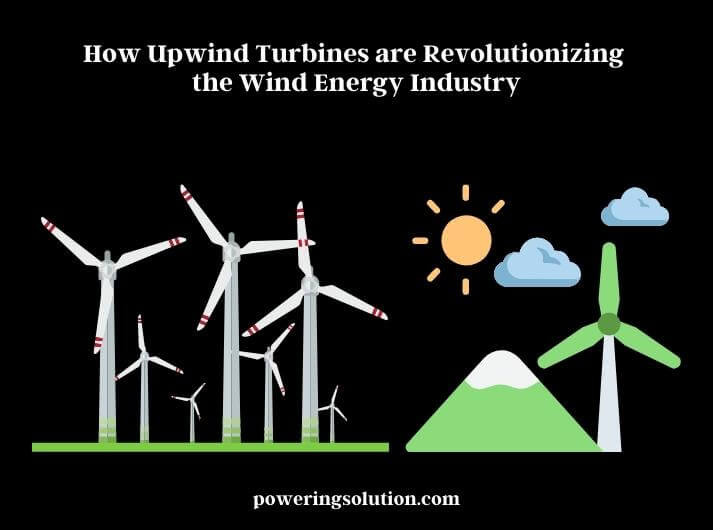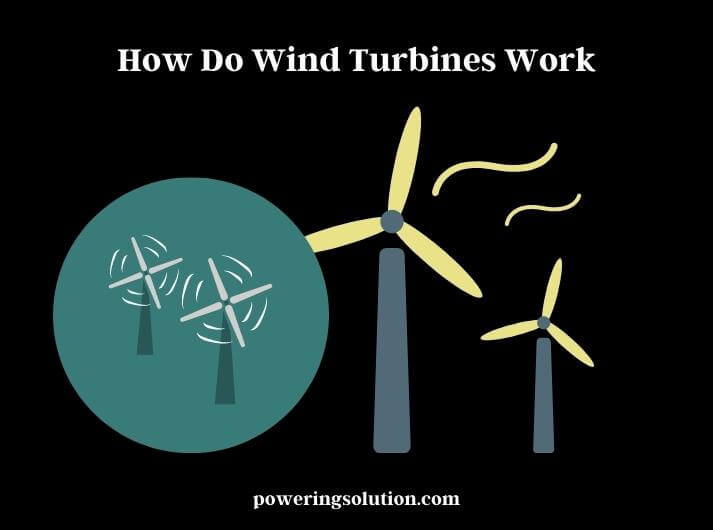The world is in dire need of renewable energy sources to combat climate change and reduce carbon emissions. Wind energy is one of the most promising forms of renewable energy, and with the recent advancements in technology, wind turbines are becoming increasingly efficient and cost-effective.

One of the latest innovations in wind turbine technology is the upwind turbine, which is revolutionizing the wind energy industry in several ways.
What is Wind Energy?
Wind energy refers to the kinetic energy of the wind that is harnessed and converted into usable electricity. Wind energy is a renewable and clean source of energy that does not produce harmful emissions or contribute to climate change.
Wind energy is typically generated using wind turbines, which capture the energy of the wind and convert it into electrical power. Wind energy is becoming an increasingly important source of electricity, with many countries around the world investing in wind farms and wind energy projects to reduce their reliance on fossil fuels and transition to more sustainable and eco-friendly energy sources.
How Do Wind Turbines Work?
Wind turbines work by harnessing the kinetic energy of the wind and converting it into electrical energy. Wind turbines typically consist of three main components: the rotor, the generator, and the tower.
The rotor consists of a series of blades that are connected to a hub. As the wind blows, it causes the blades to spin, and the hub rotates with them.
The rotor is connected to a generator through a shaft. As the rotor turns, it spins the generator, which converts the rotational energy into electrical energy.

The tower is the structure that supports the rotor and generator. It is typically a tall, steel or concrete structure that raises the rotor to a height where it can capture the maximum amount of wind energy.
In addition to these main components, wind turbines also have a yaw system, which is responsible for turning the rotor so that it faces the wind, and a control system, which monitors and regulates the operation of the turbine.
As the wind blows, it causes the rotor to spin, which in turn spins the generator and produces electricity. The electricity generated by the wind turbine can be used to power homes, businesses, and other electrical devices.
Wind turbines work by harnessing the power of the wind to generate clean and renewable energy, making them an important part of the transition to a more sustainable and eco-friendly energy system.
Understanding Wind Turbine Design
Wind turbines are becoming increasingly popular as a source of renewable energy, with their ability to generate electricity from the power of the wind. The design of a wind turbine is crucial to its efficiency and effectiveness. In this article, we will discuss the different components of a wind turbine and how they work together to generate clean energy.
Blades
The blades are the most recognizable part of a wind turbine. They are designed to capture the kinetic energy of the wind and convert it into rotational energy. The blades are usually made of composite materials or fiberglass, which are lightweight and strong. The shape of the blade is crucial to its efficiency, with a curved shape that allows it to generate lift and reduce drag.
Rotor
The rotor is part of the turbine that rotates as the wind turns the blades. The rotor is connected to a shaft, which is connected to a gearbox that increases the rotational speed of the rotor. The rotational energy is then transferred to a generator that converts it into electricity.
Tower
The tower is the structure that supports the blades and rotor. The tower must be strong and tall enough to position the blades at a height where they can capture the most wind energy. The tower is usually made of steel or concrete and can vary in height from 50 to 100 meters.
Yaw System
The yaw system is responsible for turning the turbine so that the blades are facing the direction of the wind. The yaw system is controlled by a wind vane, which detects the direction of the wind and sends a signal to the yaw motor to adjust the turbine’s orientation. This ensures that the blades are always positioned to capture the maximum amount of wind energy.
Generator
The generator is the component that converts the rotational energy of the rotor into electricity. The generator is usually a synchronous generator, which operates at a fixed speed and produces a stable output voltage. The output of the generator is then sent to a transformer that increases the voltage for transmission to the electrical grid.
Control System
The control system is responsible for monitoring and regulating the operation of the wind turbine. The control system collects data on the turbine’s performance, including wind speed, blade pitch, and generator output, and adjusts the turbine’s operation to optimize efficiency and performance. The control system also includes safety features, such as over speed protection, to prevent damage to the turbine in high wind conditions.
Advantages of Upwind Turbines
- Increased Efficiency:
Upwind turbines are designed to face the wind direction, which means they can capture more wind energy and convert it into electricity. This is because the blades are positioned ahead of the tower and the rotor, which allows them to harness the energy from the wind before it passes through the rotor. This design results in increased efficiency and higher power output.
- Improved Performance:
Upwind turbines are also known for their improved performance, especially in high wind conditions. The upwind design reduces turbulence and wind shear, which can cause the blades to stall or vibrate, leading to reduced power output and increased wear and tear. With upwind turbines, the blades remain stable and can generate more power, even in turbulent conditions.
- Reduced Noise:
Another benefit of upwind turbines is that they produce less noise compared to downwind turbines. This is because the blades are positioned ahead of the tower and the rotor, which reduces the amount of turbulence and noise generated by the blades.
- Lower Maintenance Costs:
Upwind turbines have fewer moving parts and require less maintenance compared to downwind turbines. This is because the blades are positioned ahead of the tower and the rotor, which reduces the stress and wear on the blades and other components. This translates to lower maintenance costs and longer turbine lifespan.
- Higher Tower Height:
Upwind turbines can be built with taller towers, which allows them to capture more wind energy at higher altitudes where the wind is stronger and more consistent. This also means that upwind turbines can be installed in areas with lower wind speeds, which expands the potential locations for wind energy projects.
Challenges and Limitations of Upwind Turbines
While upwind turbines are revolutionizing the wind energy industry, they are not without their challenges and limitations. Some of the key challenges and limitations of upwind turbines include:
Noise: Upwind turbines can generate significant noise pollution, especially at high wind speeds, which can be a problem for people living nearby.
Maintenance: Upwind turbines require regular maintenance to ensure they continue to operate efficiently and safely. This can be costly and time-consuming, especially for large wind farms with many turbines.
Space requirements: Upwind turbines require a significant amount of space to operate, which can limit their deployment in areas with limited land availability.
Wind variability: The performance of upwind turbines is highly dependent on wind speed and direction. As such, they may not be the most suitable option for areas with highly variable wind conditions.
High upfront costs: The initial capital costs of installing upwind turbines can be high, which may make them less accessible to smaller developers and investors.
Environmental impacts: While upwind turbines are generally considered to be a clean and sustainable source of energy, their installation and operation can have negative environmental impacts, such as disruption to wildlife and habitats.
Despite these challenges and limitations, upwind turbines remain a promising and important technology in the transition to a more sustainable and renewable energy system. Ongoing research and development efforts are focused on addressing these challenges and improving the efficiency and cost-effectiveness of upwind turbines, which will help to further revolutionize the wind energy industry.
Common Questions & Response
How Do Upwind Turbines Differ From Downwind Turbines?
Upwind turbines are designed to face the wind direction, while downwind turbines face away from the wind. This design results in improved performance and efficiency for upwind turbines.
What are the Advantages of Upwind Turbines Compared to Horizontal Axis Wind Turbines in the Wind Energy Industry?
Upwind turbines have a higher efficiency compared to horizontal axis wind turbines due to their ability to easily adapt to changing wind directions. This allows for a more consistent operation of wind turbines, leading to increased energy production. Additionally, upwind turbines are less affected by turbulence, resulting in a more stable and reliable energy output.
Are Upwind Turbines More Expensive Than Downwind Turbines?
Upwind turbines may have a higher initial cost, but they are more cost-effective in the long run due to their increased efficiency and lower maintenance costs.
How Much Energy Can a Single Wind Turbine Produce?
The amount of energy that a single wind turbine can produce depends on various factors, such as the size and type of the turbine, the wind speed and direction, and the efficiency of the turbine. On average, a modern wind turbine can produce anywhere from 2 to 6 megawatts of electricity, which is enough to power several hundred homes.
What is the Lifespan of a Wind Turbine?
The lifespan of a wind turbine is typically around 20 to 25 years, although this can vary depending on factors such as maintenance, location, and environmental conditions. With proper maintenance and care, some wind turbines have been known to operate for up to 30 years or more.
You have to know the history and development of Darrieus Wind Turbines, Follow the article for an explanation.
Bottom Line
Upwind turbines are revolutionizing the wind energy industry by providing a clean, renewable, and sustainable source of energy. Despite their challenges and limitations, upwind turbines are becoming increasingly important as we strive to reduce our reliance on fossil fuels and transition to a more eco-friendly and sustainable energy system. With ongoing research and development efforts focused on improving the efficiency and cost-effectiveness of upwind turbines, we can expect to see even more advancements in this technology in the years to come.
As we continue to explore and develop new sources of renewable energy, wind energy remains one of the most promising and accessible options. By harnessing the power of the wind, we can generate electricity without the harmful emissions and environmental impacts associated with traditional fossil fuel-based energy sources. It is essential that we continue to invest in wind energy and other renewable energy technologies to ensure a sustainable and prosperous future for generations to come.
